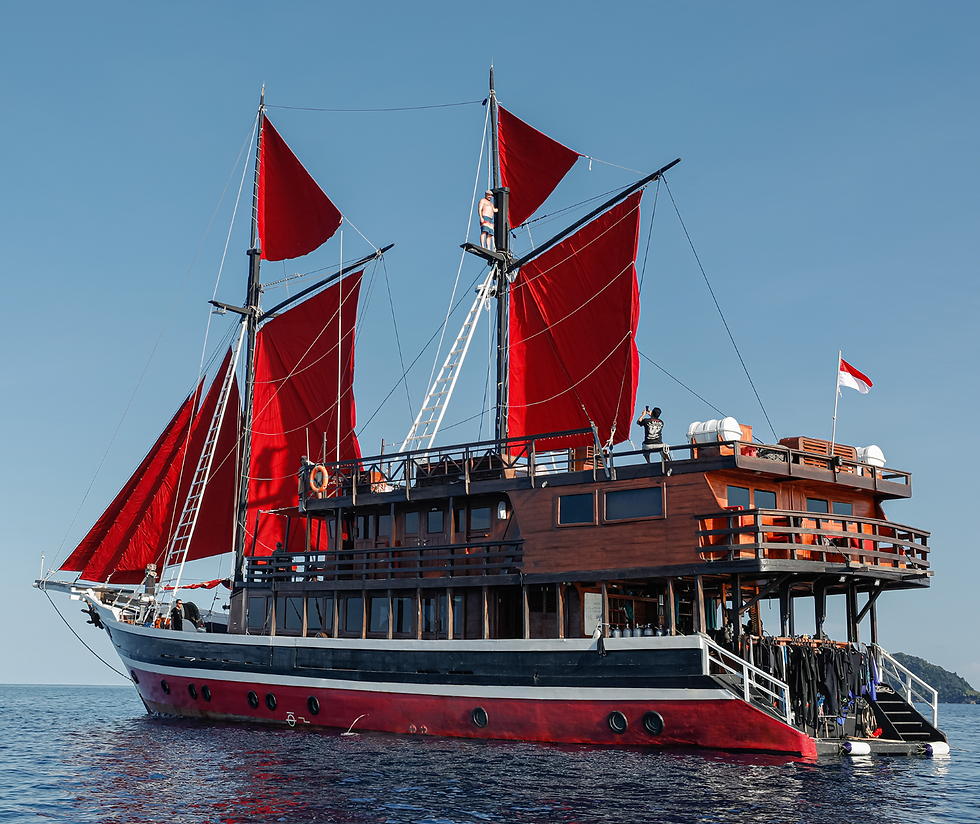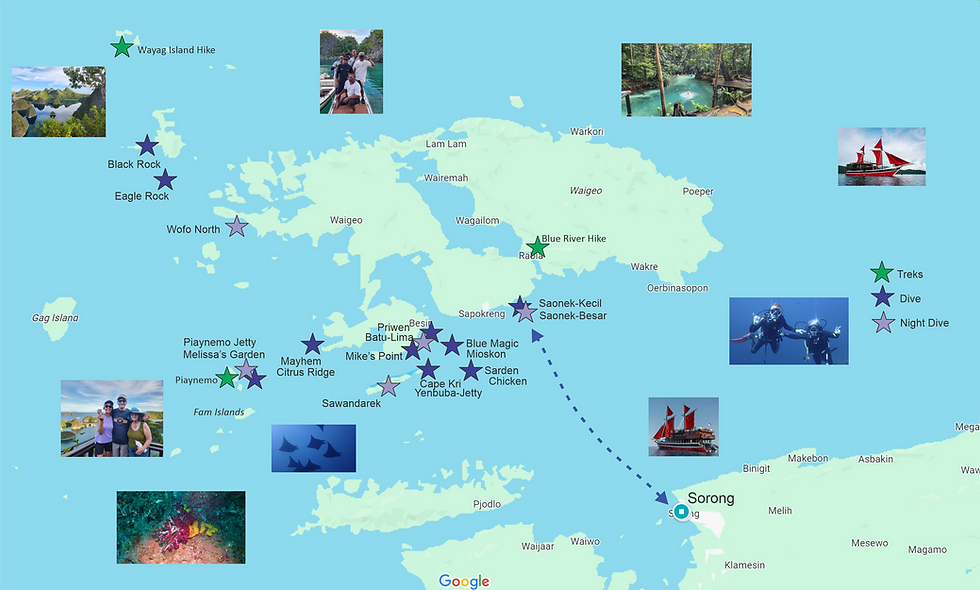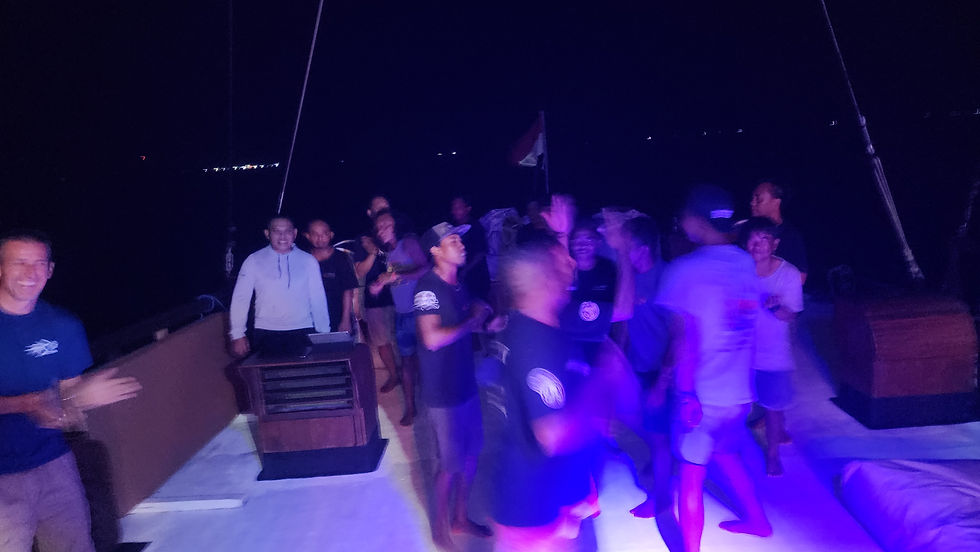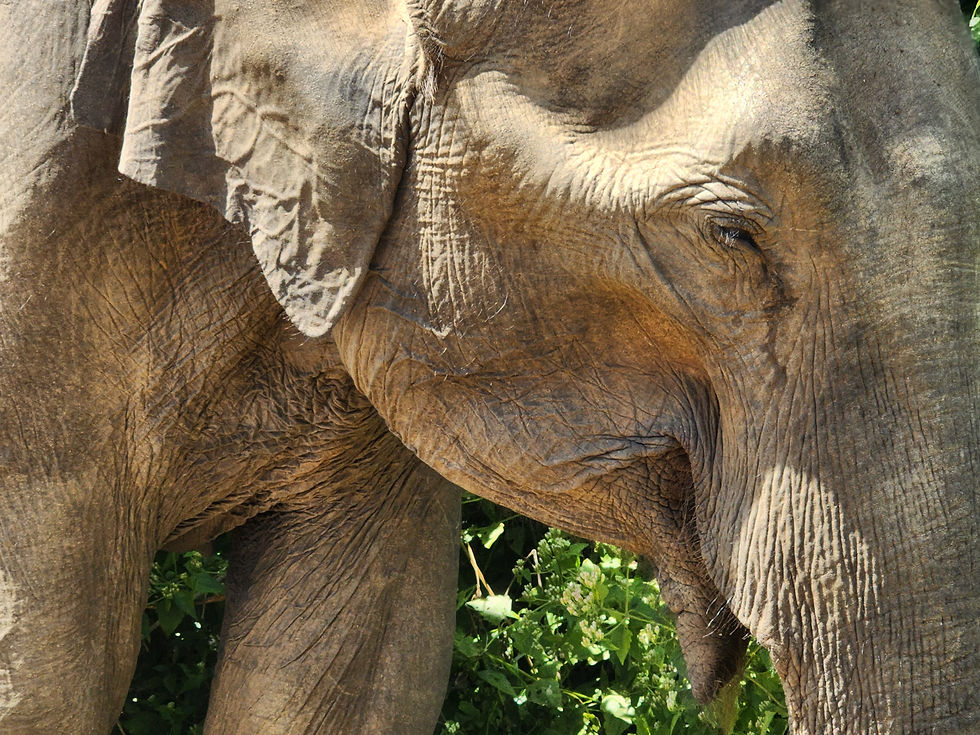Blowing Bubbles in Raja Ampat
- Bil
- Jan 1, 2024
- 13 min read
Updated: Jan 4, 2024

“Our first dive this morning is Blue Magic, yeah? There is a strong current from the west, so we will do a negative entry just west of the reef and kick hard to the bottom, hooking up when we get to the edge of the reef, yeah?”
It was 6:45 in the morning on our first full day aboard La Galigo, and we all looked at each other with a mixture of anticipation and nervousness, then headed to the stern to suit-up and clamber into the dive tender boats. I finished double-checking my straps, tank pressure and regulator as the small outboard tender moved into position and slowed to an idle. The crew helped us stand up from the seats and sit on the edge of the boat – ready for a back roll into the drink.
Most of the time this is called a positive entry, where you partially inflate your BCD before rolling in backwards, keeping you at the surface until the dive guide signals time to go down. Everyone releases air from their BCD and gradually descends to the bottom, equalizing ears as necessary.
However, when currents are strong a negative entry is required, where everyone immediately kicks for the bottom before the current sweeps you away, so having your sh*t together is a good idea. I opted to leave my new camera rig on the boat for this dive – a good idea.

We all hit the water together and I immediately got my head pointed down and started swimming hard towards the reef, trying to keep up with our guide Ambat, who was about 5 meters ahead. The other 2 are somewhere behind me. But something is wrong as the water is pushing me backwards instead of towards the coral. A few long minutes later Ambat realizes we are not going to reach the reef swimming against the current and signals to abort the dive and surface.
Boarding the tender involves five divers hanging on to a line from the boat and shedding equipment in a prescribed order and then climbing up the ladder. I removed my weight belt first and handed it to one of the guys in the boat. Then loosen and unhook the 3 straps on the BCD so the guys can haul it with the tank into the tender. Removed my fins and I’m ready to climb up and into the boat.
Somehow, we were dropped in the wrong place – either the current was really coming from the east, or we were in the wrong spot. It was never entirely clear, but the pilot changed position and we rolled in again – this time using the current to push us towards the coral reef – where we attempted to grab onto a non-living piece of rock with one hand while we deployed our reef hooks with the other.

Reef hooks are large metal claws attached to 2 meters of heavy cord with a clasp at the other end that we clip to the center of our BCDs. I am barely hanging on to a piece of hard coral and struggling to untangle my reef hook with my other hand. Ambat swims over (effortlessly, it seems!) and helps, getting a solid hookup on the reef and clipping it to the center of my BCD. Crucial to have it centered, so the current doesn't push you off to the side.
By now I am breathing pretty hard and feeling some anxiety – a new sensation for me whilst diving. I finally force myself to take my hands off the reef hook line and just let the current hold me in position, as I practice taking slow, deep breaths and relax. OK, that’s better. I look where Ambat is pointing to see many large blacktip and reef sharks patrolling just past the edge of the reef. So cool, and the rest of the dive goes smoothly, drifting past formations of beautiful coral in many shapes and sizes, surrounded by hundreds of colorful tropical fish.
Welcome to life on a liveaboard dive boat, where every dive has a different personality, from a lazy, shallow water dive with sunlight dappling the corals to a magical night dive where fantastic creatures suddenly appear out of the dark, to heart-pounding experiences as described above.

La Galigo is a 33 meter long Phinisi sailing yacht modified for scuba diving, carrying 14 divers and 14 crew. 7 private en-suite cabins provide comfortable air-conditioned quarters for the divers and a large central cabin serves as the dining room, lounge and general meeting area. We opted for the Suite which was a huge room at the rear of the upper deck, spanning the entire 8 meter width of the vessel, sporting a super comfy bed, large couch and private balcony looking out over the stern.
Our typical day started with a dive briefing at 7 am to go over details of the first dive of the day. Coffee, tea, fruit and dry cereals are always available. Then everyone makes their way to the rear to prepare. Squirm into your full-length wet suit and don your booties and weight belt. (I need 6 kg of weight – half on my belt and half in my BCD). Spit in your mask, or use soap, to keep it from fogging up, and strap your dive computer on your wrist. Grab your camera and walk down to the loading platform.
Crew already has our BCDs, tanks and fins in the tender, so we find our seat next to our gear and start getting strapped in – AFTER checking that the air is turned on and tank pressure is correct. Oh – also breath through the regulator a couple times to ensure it is working, and the air tastes ok. (I had a tank fill in Ft Lauderdale many years ago that tasted like exhaust! Problems with their air compressor)

A typical dive lasts about 45 – 60 minutes. We start out with about 200 bar (3,000 psi) and when the first person gets down to 50 bar the dive is over. I usually had 70 to 90 bar left. Even though these are all no-decompression dives, we do a safety stop at 5 meters for 3 minutes every time to give accumulated nitrogen in our blood more time to be exhaled.
After getting back in the tenders at the end of the dive we return to La Galigo where the crew helps us out of the wet suits so we can shower on the back platform. Jeffrey or one of the other guys is right there with a dry towel and there are always drinks and snacks waiting on the foredeck. A delicious breakfast is next up with a variety of foods and eggs cooked as you like. Next dive briefing in an hour and then we are off for the second dive of the day.
The vessel often weighs anchor and cruises to a new location as soon as the last diver is aboard. The seas were very calm most days for the duration of our trip. They were frequently so glassy-smooth that the reflections of clouds and islands in the many-hued blue sea water seemed straight out of a dream. We did have a couple of showers and one thunderstorm during the night, but the weather was mostly perfect.

Lunch followed the second dive with another great meal laid out buffet-style in the lounge, where everyone chatted about the last dives, trying to remember and identify everything we had seen. Some us still had “old school” paper log books to record details for each dive.
Following an hour or two respite it was time for the 3rd dive briefing, while everyone collected their charged-up batteries for cameras and lights. My sister always carried her dive light during the day dives as it is a big help spotting creatures under the coral, and showing the true, brilliant colors when the deep sea had filtered out all the reds and yellows from the sunlight.
There was always a nice snack waiting after the 3rd dive, such as pandan flavored sweet rolls, cookies, mango juice and fresh fruit. Everyone could relax for a while before the final briefing around 18:00 for the night dive. These were generally shallow water dives, sometimes around a pier or jetty. The crew supplied lights to anyone that did not have their own.
Night dives are usually about “macro” subjects – small and tiny critters, and other things that are more active at night, like some crabs and cuttlefish. I am constantly amazed at the ability of our dive guides to spot miniscule creatures I never would have seen. One of the coolest is the bobtail squid – a brilliant blue animal the size of your fingernail that hides by burrowing in the sand. We also saw sea horses, flatfish, turtles and pipefish.

It can get confusing when more than one dive group converges in the same area. I sometimes had to flash my light around until I saw Aghi’s blue & orange fins to ensure I was in the right group.
Returning to the ship after the night dive, we stripped off our gear and headed to our cabins to shower off (hot water!) and get dressed for dinner. Every meal was wonderful with a wide variety of vegetarian choices such as tempeh and tofu, chicken, fish & beef. Many veggies, salad, and of course – rice! We were introduced to several new fruits & veggies local to Indonesia. All were delicious.
After a tasty, small dessert, it didn’t take long for the dining room to empty out. Four dives a day left everyone ready for an early bedtime – no long nights playing cards or swapping stories for this bunch!
Raja Ampat means the Four Kings, from a local mythology that tells about a woman who finds seven eggs. Four of the seven eggs hatch and become kings that occupy four of the biggest islands: Salawati, Batanta, Waigeo and Misool. (the other three became a woman, a ghost, and a stone.)

Raja Ampat is an archipelago comprising over 1,500 small islands, cays, and shoals in West Papua Province, Indonesia. The territory within the islands of the Four Kings is enormous, covering 9.8 million acres of land and sea, home to 540 types of corals, more than 1,000 types of coral fish and 700 types of mollusks. This makes it the most diverse living library for the world's coral reef and underwater biota.
This makes the area a prime destination for scuba divers wishing to experience some of the most pristine waters in the world. Previously accessible only to divers on liveaboard boats there are now dive centers and resorts opening on several of the larger islands. They run the gamut from tiny open-air huts with questionable equipment to luxurious eco-resorts.
Getting there is not simple, either. Most visitors fly from the capital of Indonesia, Jakarta to Sorong in West Papua, where most dive boats call home port. For some weird reason, all flights from Jakarta to Sorong leave at 5 minutes past midnight! Go figure. Flight is 4 hours and crosses 2 time zones. Our flight traveled through many thunderstorms. Ugh.

We arrived in Sorong two days before the boat trip, to allow for the frequent delays/cancellations of Batik Airlines, and for my sister to decompress from her flight in from California. We stayed at the Aston Hotel which was very nice with a great breakfast buffet and rooftop bar where we had drinks watching the full moon rise.
Sorong is the largest city and the capital of the Indonesian province of Southwest Papua, located on the western tip of the island of New Guinea. Population is about 285,000, with 55% Christian & 45% Muslim. Growth has been tremendous since 2010 with the building of many roads linking other towns in Papua's Bird's Head Peninsula, and the burgeoning diving industry.
We did not find a real “town center” or square but did visit a couple of “respectable” department stores, anchored by a KFC! We also used our legs to cover quite a few miles around town, where the streets were lined with shops selling cell phones, motorbike repair shops, food stalls, mini-grocers, various hardware and utilities. We did find a couple that had a good supply of beautiful batik clothing, and some old handicrafts.
We also seemed to draw a crowd on many of the side streets. I suppose most westerners do not go out walking around. Many children would start following us, asking to take photos, and many passers-by on bikes or cars would honk and wave. It was quite a fun experience.

One rainy night we ate at Republik Seafood, the big favorite of locals, featuring a large metal charcoal grill in front. Famous for tuna cheeks! The owner was very nice and she sat with us to explain the menu, and which sauces were “mild” and which were not. (pro tip – NONE are mild!) I had the mini lobster, and they were very tasty.
Meanwhile back on the boat we also had some landlubber excursions to explore and hike. The first one was to Piaynemo, a Geological Heritage Site in the West Waigeo District. The guys loaded us up in the two tenders for a 15 minute cruise to the well-maintained docks. From there it was a steep uphill walk on wooden steps to the lookout for a spectacular view of the karst formations.
This iconic view is featured on the Indonesian 100,000 Rupia note. Unlike so many beautiful parks in SEA, we were the only ones on the island. The only sounds were the tropical birds and insects, and the gentle breeze soughing through the trees.

The next trip was on the island of Wayag, which we reached after cruising north across the equator during the night. (no tatoos – haha). Our first hint that this trek was a bit more adventurous came when Fareez warned us not to wear flip-flops, and wear your gloves if you have any. What? Gloves?!?!
The guys ferried us into shore, passing small islands where the rocky shoreline was undercut with ages of sea water. The boat pulled up to one of these spots where a short wooden ladder reached from the water to the rocks, where we looked up to face some very steep and craggy cliffs. The porous limestone rock was sharp and hard, but thankfully solid with few loose rocks, and plenty of “handholds”. Some trees and two strategically placed ropes aided our ascent, which we all completed safely, if slowly.
The final viewpoint was well worth the exertion – even more amazing than Piaynemo, if possible. The pristine waters reflecting a dozen shades of blue and green amid the picturesque formations of karst island. Once again we were alone in an amazing paradise with no other human being in sight.
Our final excursion on terra firma once again had the guys driving us up a large cove in Waigeo Island, stopping at a small village to pick up a young local guide for each boat. We continued up a small river, until the depth became too shallow and we had to debark. Now we followed our guides, splashing through the shallows for a hundred meters or so, and then turning inland on a dirt path.

Fifteen minutes later we arrived at Kali Biru – the Blue River. This small river flowing through the dense Waisai forest is always a startling shade of azure, owing to the clarity of the water and nature of the bottom. The cool waters are a popular place for visitors to jump in and float around, chilling away the exertions of an arduous hike. (haha – not!)
Unlike the other two treks this was a busy place. No one around when we first arrived, but were shortly joined by a group of local tourists, and then a large group of senior travelers. When we were walking back towards our boats, we discovered some of the other groups had floated all the way down to meet the river where we were walking! Wish we had spotted that lazy shortcut.
I bought an underwater camera rig after seeing setups of fellow divers in the Philippines, and some amazing photos posted on FB and Instagram. It centered around an Olympus TG-6 camera with an underwater housing, and a 4300 lumen video light. A U-shaped metal “tray” mounts the parts, along with 2 large flotation arms to add buoyancy.
The idea is for the rig to have neutral buoyancy, so it is not trying to sink or float as you are swimming with it. My first test showed it was very negative – sank right to the bottom – so I bought a cheap pair of flip-flops, cut them up and taped around the arms. Much better. But one oddity presented itself when diving: at the surface it was slightly positive, which was good, but at depth it was negative, and would sink! Wth? Most plausible reason so far is the small amount of air inside the housing. To be determined…

Actually getting good photos is a real challenge! This camera has many settings like a “real” SLR device, plus the compensation for loss of light/color underwater. This video light, like most, is only good for close objects, and that is what this camera excels at. Camera, I said – not operator! To get great close ups, you have to get really close to the subject, get the light focused directly on the subject, and somehow get your face close to the viewfinder so you can center the object and get good focus. Oh – and make sure you don’t move while doing this, even though the current or other divers are trying to push you around! Haha – fun times.
I did mange to get a few good shots, but more importantly I have a good record of many of the fish, animals and coral I saw, even if they are not Instagram-worthy. Some of the cooler things we saw were:
· Two octopus mating, until we disturbed them. They still hung around for a while
· Several tiny and colorful bobtail squid, that would burrow into the sand to hide
· Many moray eels hidden in the coral, with their fearsome heads exposed
· One large oceanic manta ray
· Several tessellated wobbegong sharks – unique to these waters
· Amazing varieties of healthy, beautiful corals: hard, soft, fan, staghorn
· Funny looking slipper lobsters
· Large school of mobula rays (devilfish)
· Colorful giant clams and flashing fire clam
· Many big green turtles
· Several varieties of “Nemos” (clownfish) hiding in their anemones
· Huge schools of many types of tropical fish
· Barracuda “tornado”…haha…really
It is just an amazing feeling to be weightless and drifting along underwater when the conditions are right. Everywhere you look whilst scuba diving in Raja Ampat there is an abundance of life going on and on, from the tiniest fish and mollusks to the largest sharks in the distance. Reef fish pecking at the coral and other fish chasing others from their territory. A very magical experience, and I am so thankful to experience it.

The crew made our last night a very memorable occasion. They prepared an especially delicious dinner and served it under the stars on the top deck, with the addition of a few “party lights”. We brought out our bottle of Dome Vodka (the only Vodka to be found in Sorong, believe me!) to share and the party was started.
The whole crew came up and to our delight, sang and danced to a couple of local tunes. By the 3rd song the rest of us had joined in even though we were not quite up to speed with the words. As some of the guys had to get back to “battle stations”, Ian and Heather took over DJ duties, playing great dance hits for several hours. Many of us got more exercise dancing that night than the previous dives and hikes!

The overnight cruise back to Sorong that night ran through a little chop, as I woke up once around 3am and the ship was rolling side to side. No – it wasn’t the vodka, smart ass. But not enough to be uncomfortable and when we rolled out for breakfast the next morning we were anchored up in Sorong Harbor.
Always sad to say farewell to new friends and end such an exciting adventure, but we will always have memories and easy methods to stay in touch with each other across the planet.
Terima Kasih, and Selamat Tinggal!








Comments